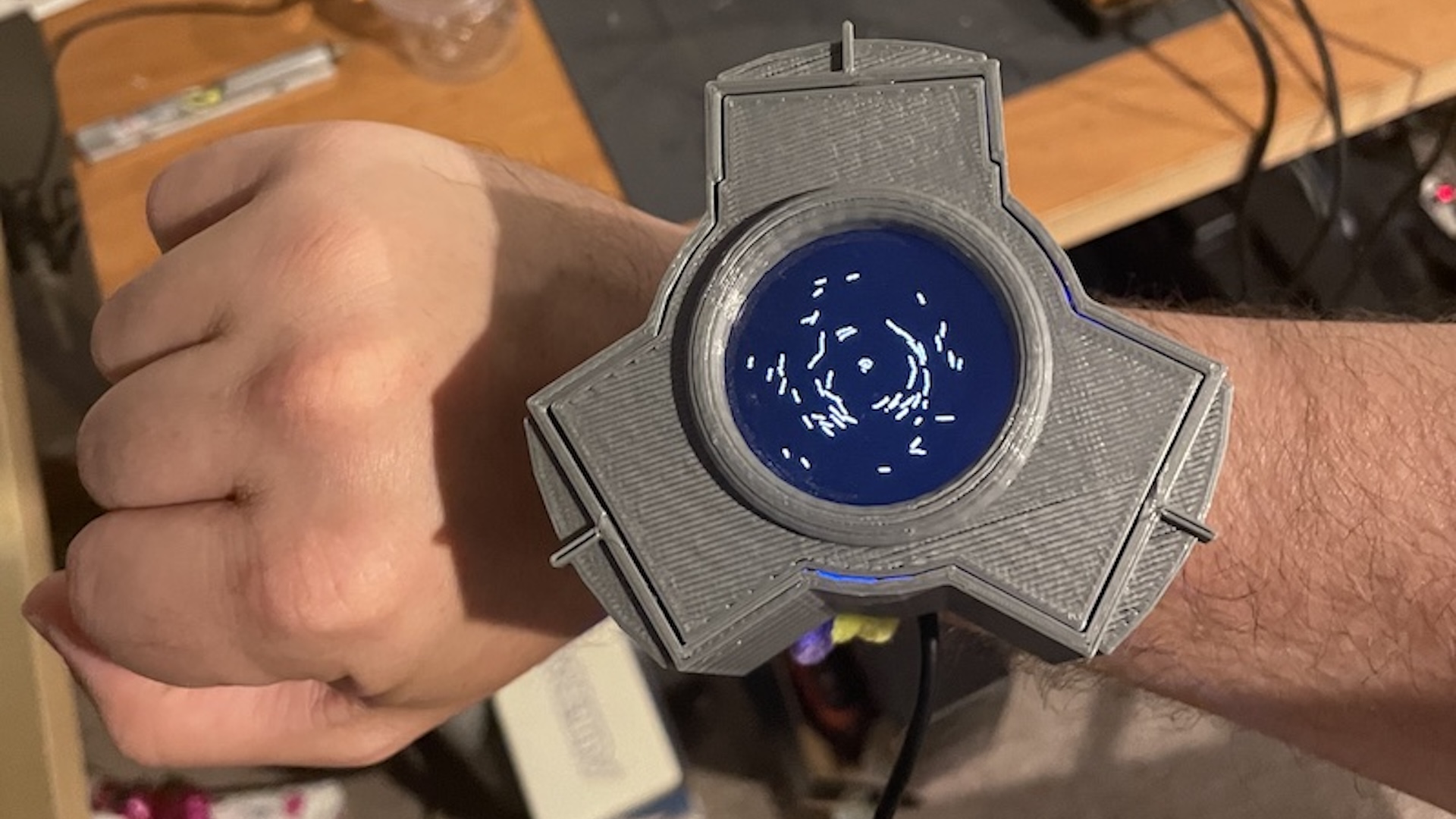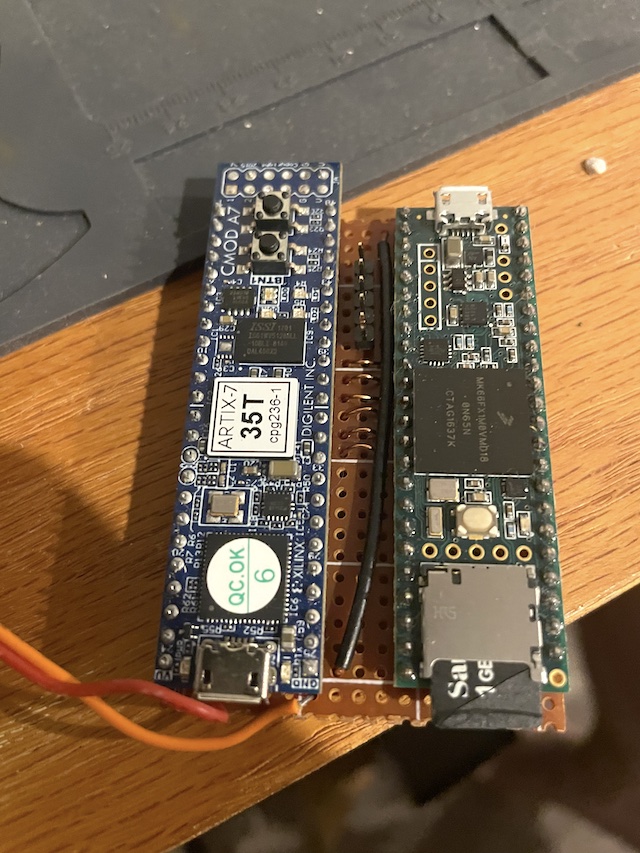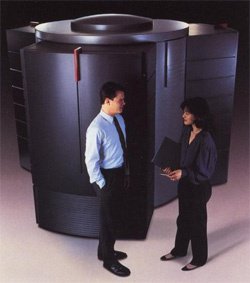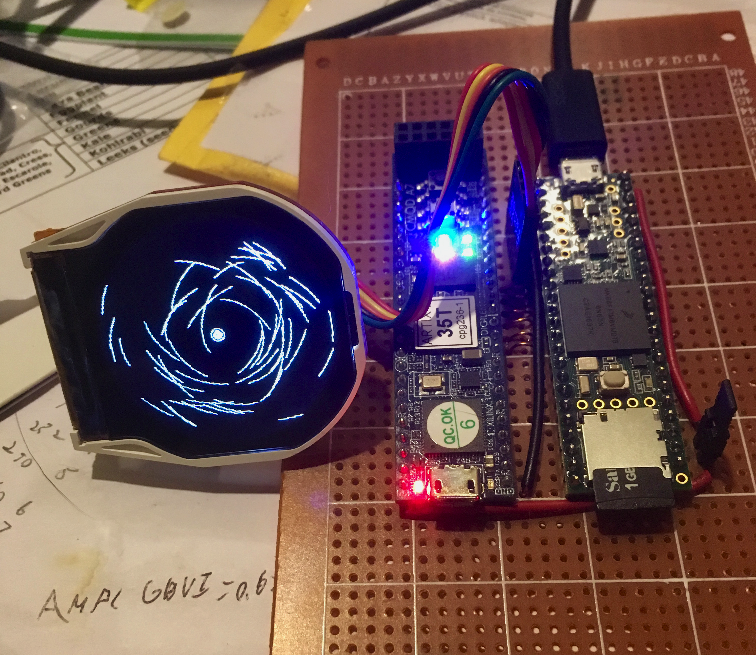Supercomputer designer shrinks the Cray C90 to wristwatch size … sort of
You can watch 63 of Jupiter's moons in orbit from your wrist, but good luck telling the time.

An electrical engineer who helps design supercomputers has built a miniaturized version of the Cray C90 that fits inside a wristwatch. The marriage of 3D printing, an OLED display, and an FPGA development board yielded a tiny Cray that he can wear on his wrist and, with great difficulty and concentration, use to tell time.
To build the 1/25-scale Cray C90 wristwatch, Chris Fenton designed a model of the Cray Y-MP C916 small enough to wear as a watch. He built it with a 3D printer, trimmed the required circuit boards to fit inside, and mounted the OLED display. It also has a battery with a built-in charger, and Fenton says the watch can accommodate a NATO-style wrist strap.
The system is run off a Diligent CMOD-A7 FPGA development board. This contains a Cray CPU core running at 105 MHz, the actual clock speed of Cray’s J90. The C90, mind you, runs at 244 MHz. The front-end processor is a Teensy 3.6 microcontroller, controlling reset signals and the SPI interface going into the Cray CPU. The Teensy MCU also drives the OLED display.


Next, Fenton needed software on the watch. Since it was a for-fun project and part of what he calls his “series in Cray-related computational necromancy,” the electrical engineer pretty much threw usefulness out the window. His work and interests have made him enjoy doing N-body gravity simulations, so that’s what he did with the Cray C90 superwatch. N-body gravitational simulations use mathematical formulas to demonstrate, in this case, how a planet and its moons interact gravitationally.
In Python, he wrote an n-body simulation of Jupiter and 63 of its moons. Mimicking Cray vector instructions, he developed a program for the watch that shows a free-running simulation of Jupiter and 63 of its moons orbiting the gas giant. The coordinates come from NASA’s Horizons system. The software displays each moon based on that data in the ecliptic plane around a circle designating Jupiter.
The maker says that using his supercomputer wristwatch “should be as incomprehensible as my motivation for creating it in the first place,” and it sounds like he hit that mark precisely. To actually tell the time on the wristwatch, you look at the positions of Jupiter’s moons. Because all of us know where those lunar bodies will be at particular times of the day...
The final product is programmable, and it looks like a miniature version of a Cray supercomputer. Fenton says it “pushes the boundaries of usefulness and complexity.” I would tend to agree, adding that I’d be nervous about wearing it — the watch appears to be several inches tall and I can see myself whacking it on doorframes every time I walk through one. Then again, I've got to admit it looks really cool.
Get Tom's Hardware's best news and in-depth reviews, straight to your inbox.

Jeff Butts has been covering tech news for more than a decade, and his IT experience predates the internet. Yes, he remembers when 9600 baud was “fast.” He especially enjoys covering DIY and Maker topics, along with anything on the bleeding edge of technology.
-
kanewolf Having worked with REAL C90s, what is missing is the 1/25 scale cooling and motor generator that would require at least a backpack. If that C90 watch was powered by a car battery, then there is some realism.Reply -
bit_user Reply
Lost what little interest I had, when I saw that it didn't actually execute the Cray's native code. If he's not even going to do that, then he might as well just have made a custom case for a standard smart watch.the article said:In Python, he wrote an n-body simulation of Jupiter and 63 of its moons. Mimicking Cray vector instructions, he developed a program for the watch that shows a free-running simulation of Jupiter and 63 of its moons orbiting the gas giant. -
Rob1C You're probably correct about the height: https://www.chrisfenton.com/1-25-scale-cray-c90-wristwatch/Reply
An adventurous person would get UNICOS running on their Android watch: https://github.com/andrastantos/cray-sim - just an ASM -> C (or ARM ASM) conversion.
Less nerdy could try the online simulator: https://cray.modularcircuits.com/ -
NeoMorpheus Reply
One thing that still leave me in awe is how much tech has advanced.kanewolf said:Having worked with REAL C90s, what is missing is the 1/25 scale cooling and motor generator that would require at least a backpack. If that C90 watch was powered by a car battery, then there is some realism.
Like how many times faster a current smartwatch is compared to the original Cray, for example or the famous photo of the 5MB hard drive being loaded on a truck, compared to todays SD Cards. -
kanewolf Reply
C90s were 1990s. There have been 30 years elapsed. C90s had solid state disks in the 90s!! C90s had interfaces as fast as a 10GE interface in the 90s.NeoMorpheus said:One thing that still leave me in awe is how much tech has advanced.
Like how many times faster a current smartwatch is compared to the original Cray, for example or the famous photo of the 5MB hard drive being loaded on a truck, compared to todays SD Cards.
Granted it took rooms of equipment (the SSD was an entire cabinet). What you should be in awe of is how advanced the c90s were for the 1990s. -
NeoMorpheus Reply
I am!kanewolf said:C90s were 1990s. There have been 30 years elapsed. C90s had solid state disks in the 90s!! C90s had interfaces as fast as a 10GE interface in the 90s.
Granted it took rooms of equipment (the SSD was an entire cabinet). What you should be in awe of is how advanced the c90s were for the 1990s.
Was not aware of any of those facts! -
keninkc Nothing new under the sun ... when John Harrison won the Longitude Prize in 1773 for constructing the first chronometer usable at sea for finding longitude, it's primary competition was the astronomical method called "lunar distances" which used the moon's location against the backdrop of stars to determine the time, and hence determine longitude. Another astronomical method was based on eclipses of the Jovian moons by Jupiter. The eclipses could be used to determine time quite accurately. It was very difficult to train a telescope on the moons to catch the eclipses, though. The dependency on clear weather and a steady deck for the astronomical methods led to the adoption of the chronometer as the gold standard in navigation . . . at least until the advent of radio navigation (LORAN and Decca) and GPS eclipsed the sextant/chronometer method.Reply
The n-body solution of this watch harkens back to the Jovian eclipse method of telling time . . .
Also, I worked for a large oil company who had a Cray computer in their data center in Dallas back in the day. For some reason, the covers on the Cray were a shade of pink. Mary Kay cosmetics was headquartered in Dallas at the time and were known for awarding pink cadillacs to their top salespeople . . . of course, it had to happen . . . the oil company's Cray computer came to be known as the "Mary Cray". Perhaps a pink "special edition" of the watch is in order. <grin>
Admin said:An electrical engineer who designs real-life supercomputers took his love for Cray and built a supercomputer-inspired wristwatch.
Supercomputer designer shrinks the Cray C90 to wristwatch size … sort of : Read more

